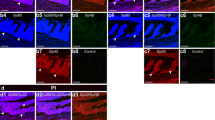Abstract
The pars tuberalis mainly consists of the secretory cells specific to this portion of the pituitary. We examined the localization and development of luteinizing hormone (LH) and chromogranin A in the chicken pars tuberalis by immunohistochemistry. The vast majority of the chicken pars tuberalis was occupied by cells immunoreactive for both LH and chromogranin A. Furthermore, immunoblot analysis of chicken pars tuberalis extracts with LH antiserum demonstrated that two bands, the large α-subunit and small β-subunit of the LH molecule, were expressed in this tissue as well as in the pars distalis. A band for chromogranin A was also detected in pars tuberalis extracts with chromogranin A antiserum. In contrast to the cells of mammalian species that contain only a few small secretory granules, the specific cells of the chicken pars tuberalis were characterized by the presence of many secretory granules ranging from 90 to 400 nm in diameter. Postembedding immunogold labeling showed that gold particles representing immunoreactivity for LH were densely located on all secretory granules of the secretory-specific cells. Many secretory granules, especially the large ones, of the cells were also loaded with immunogold particles for chromogranin A. Double immunogold labeling confirmed that LH and chromogranin A were colocalized on the same secretory granules. During embryonic development, the primordium of the pars tuberalis was first detected at 8 days of incubation as a small group of cells containing LH- and chromogranin-immunoreactive cells. In the pars distalis, the onset of LH and chromogranin expression occurred earlier, at 6 days of incubation. At 10 days of incubation, the pars tuberalis primordium became large cell masses consisting of LH- and chromogranin-immunoreactive cells, which were located close to the median eminence. Subsequently, the primordium extended along the median eminence progressively with age. At 14 days of incubation, it reached to the rostral end and surrounded the median eminence as slender cell cords. These results indicate that specific cells of the chicken pars tuberalis synthesize a glycoprotein hormone related to the LH molecule, which is stored in the secretory granules together with chromogranin A. The pars tuberalis may be involved in the regulation of gonadal function in a different way from that of the pars distalis.
Similar content being viewed by others
Author information
Authors and Affiliations
Additional information
Accepted: 26 August 1997
Rights and permissions
About this article
Cite this article
Kameda, Y., Miura, M. & Ohno, S. Localization and development of chromogranin A and luteinizing hormone immunoreactivities in the secretory-specific cells of the hypophyseal pars tuberalis of the chicken. Histochemistry 109, 211–222 (1998). https://doi.org/10.1007/s004180050220
Issue Date:
DOI: https://doi.org/10.1007/s004180050220




